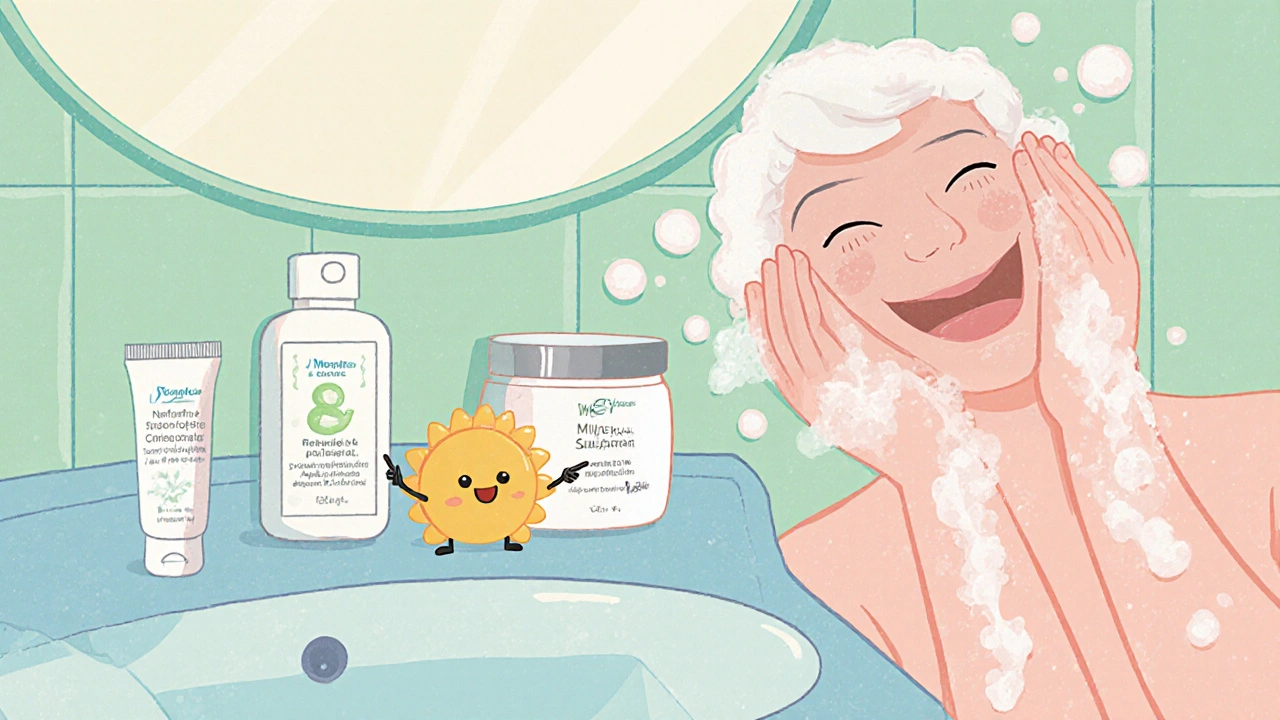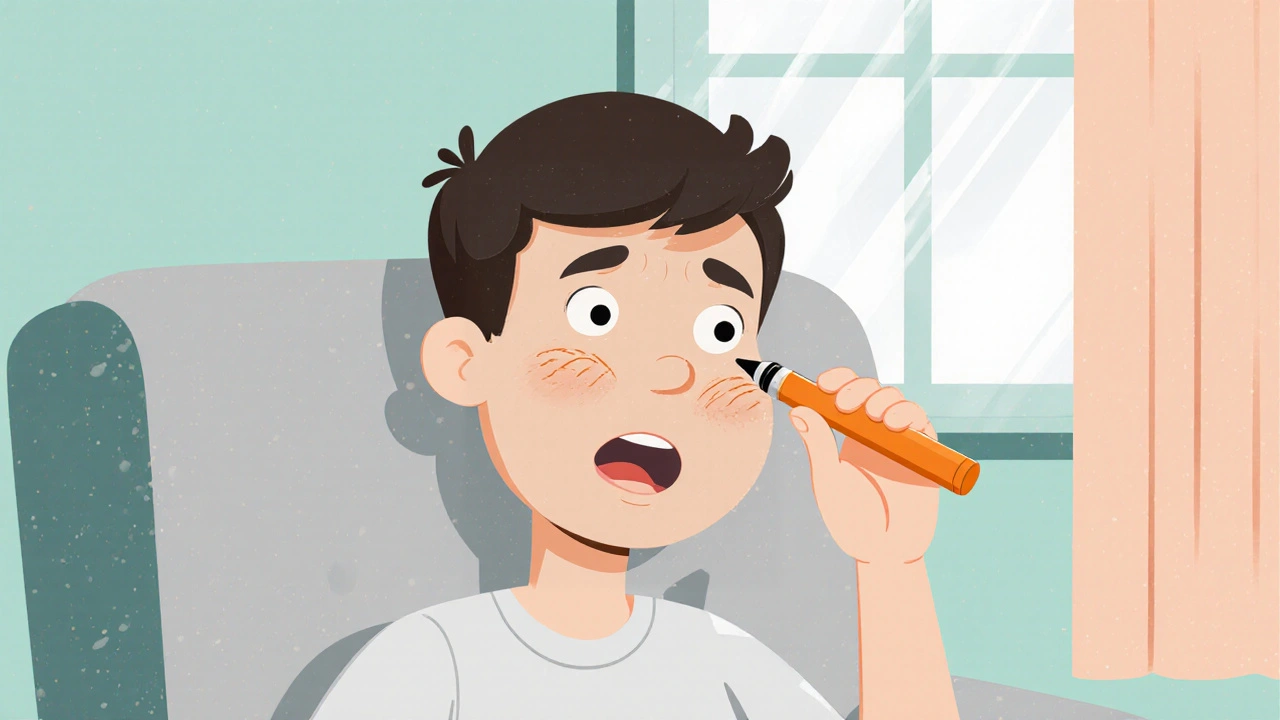Prednisolone Acne Treatment Advisor
How severe is your acne?
This tool helps determine the most appropriate treatment based on your symptoms
Ever noticed a sudden flare‑up after starting a steroid shot? You’re not alone-many people on Prednisolone a synthetic corticosteroid prescribed for inflammation, autoimmune disorders, and allergic reactions develop breakouts that feel impossible to control. This guide walks you through why prednisolone acne shows up, what you can do today to keep it in check, and when you really need a dermatologist’s help.
What Exactly Is Prednisolone‑Induced Acne?
Prednisolone‑induced acne a form of steroid‑triggered acne that typically appears as papules, pustules, or oily patches on the face, chest, and back is different from teenage acne. It tends to emerge quickly after the dose ramps up, and the lesions can be deeper and more inflamed. The condition isn’t a sign that the medication is failing; it’s a side effect of how prednisolone alters your skin’s biology.
Why Steroids Spark Breakouts
Prednisolone belongs to the broader class of Corticosteroids hormone‑like drugs that reduce inflammation by suppressing the immune response. While they calm down swelling, they also increase the production of Sebum the oily substance secreted by skin’s sebaceous glands. More sebum means clogged pores, and the suppressed immune system can’t clear the bacteria that love those clogged pores. The result? A rapid rise in acne lesions.
Spotting the Early Signs
- New, shiny pimples that appear suddenly, often within days of starting prednisolone.
- Lesions concentrated on the forehead, cheeks, chest, and upper back.
- Increased redness or a feeling of tight, oily skin.
- Acne that doesn’t respond to your usual over‑the‑counter routine.
If you notice any of these, it’s time to tweak your skincare.
Build a Gentle, Steroid‑Friendly Skincare Routine
- Cleanse twice daily with a Gentle cleanser a sulfate‑free, pH‑balanced wash that removes excess oil without stripping skin. Look for ingredients like glycerin or panthenol.
- Moisturize within two minutes of washing. Choose a Non‑comedogenic moisturizer a lightweight cream that hydrates without blocking pores. Hyaluronic acid or ceramide‑based formulas work well.
- Sun protection is a must. UV rays can worsen inflammation. Opt for a mineral sunscreen (zinc oxide or titanium dioxide) with at least SPF30.
- Avoid heavy makeup or skin‑care products that contain oil, alcohol, or fragrance, as they can aggravate the breakout.
These basics create a calm canvas for any targeted treatment you add later.

Over‑the‑Counter (OTC) Tools You Can Use
| Category | Key Ingredient | How It Works | Typical Cost (USD) | When to Choose |
|---|---|---|---|---|
| OTCSpot Treatment | Benzoyl peroxide (2.5‑5%) | Kills acne‑causing bacteria and reduces oil. | $5‑$12 | Few isolated pimples; mild inflammation. |
| OTCDaily Treatment | Salicylic acid (0.5‑2%) | Exfoliates dead skin cells, unclogs pores. | $8‑$15 | Comedo‑dominant breakouts; oily skin. |
| PrescriptionTopical | Retinoids (tretinoin, adapalene) | Normalizes skin cell turnover, prevents clogged pores. | $20‑$45 (depending on insurance) | Persistent, inflammatory lesions; need faster results. |
| PrescriptionOral | Low‑dose tetracycline antibiotics (doxycycline, minocycline) | Reduces bacterial load and anti‑inflammatory effect. | $25‑$60 per month | Severe or widespread acne not responding to topicals. |
Start with the gentlest option that addresses your main symptom. If you’re only dealing with a few red bumps, a benzoyl‑peroxide spot treatment might be enough. For more widespread inflammation, a prescription retinoid or oral antibiotic is often necessary.
Prescription Treatments Worth Knowing
When OTC products fall short, your doctor may suggest one of these proven options:
- Topical retinoids - Tretinoin, adapalene, or tazarotene work by speeding up cell turnover, which helps keep pores clear.
- Topical antibiotics - Clindamycin or erythromycin can curb bacterial growth when combined with benzoyl peroxide.
- Oral antibiotics - Doxycycline and minocycline are commonly prescribed for steroid acne because they also reduce inflammation.
- Hormonal therapy - For women, low‑dose oral contraceptives or spironolactone can balance hormones that worsen acne.
- Isotretinoin - The most powerful acne drug, reserved for severe cases that haven’t responded to anything else.
All prescription choices have potential side effects, so discuss risks with your provider-especially if you’re already on prednisolone for another condition.
Lifestyle Tweaks That Make a Difference
- Watch your diet: High‑glycemic foods (white bread, sugary drinks) can spike insulin, which may increase sebum production.
- Stay hydrated: Water helps flush toxins and keeps skin barrier function optimal.
- Manage stress: Cortisol spikes from stress add to the hormonal mess caused by prednisolone. Simple breathing exercises or short walks can reduce flare‑ups.
- Don’t pick or squeeze: Picking spreads bacteria and can lead to scarring.
- Keep hair clean: Oily hair can transfer oil to the forehead; wash regularly if you’re using heavy conditioners.

When to Call in a Dermatologist
Even with a solid routine, some situations demand professional care:
- Acne covers more than 20% of your face or spreads to the chest/back.
- Painful cysts or nodules that feel hard under the skin.
- Scarring starts to appear after only a few weeks.
- You’re already on multiple acne medications and still see no improvement.
A dermatologist can offer procedural options-like chemical peels, light therapy, or intralesional steroid injections-that speed up healing.
Quick Checklist for Daily Management
- Cleanse with a gentle, pH‑balanced wash twice daily.
- Apply a non‑comedogenic moisturizer within two minutes of washing.
- Use a targeted benzoyl‑peroxide spot treatment on active breakouts.
- Apply sunscreen every morning, even on cloudy days.
- Limit sugary, high‑glycemic foods; drink at least 8 glasses of water.
- Get 7‑8 hours of sleep and practice stress‑relief techniques.
- Monitor changes and note any worsening-bring it to your doctor’s attention.
Stick to these steps, and you’ll give your skin the best chance to stay clear while you’re on prednisolone.
Frequently Asked Questions
Why does prednisolone cause acne even if I’ve never had acne before?
Prednisolone increases sebum production and weakens the skin’s immune response, creating an environment where acne‑causing bacteria can flourish, regardless of your past skin history.
Can I stop taking prednisolone to get rid of the acne?
Never stop a prescription without your doctor’s advice. Instead, focus on skin‑care and medical acne treatments while you continue the steroid under supervision.
Are there any natural remedies that help?
Green tea extract, zinc supplements, and tea tree oil have modest anti‑inflammatory benefits, but they should complement-not replace-clinically proven treatments.
How long will the acne last after I finish prednisolone?
Most people see improvement within a few weeks after the drug tapers off, but lingering lesions may need continued skincare or a short course of topical retinoids.
Is it safe to use retinoids while on prednisolone?
Yes, in most cases. Retinoids don’t interact with prednisolone, but they can cause dryness, so pair them with a gentle moisturizer.



17 Comments
Nicole Chabot October 16, 2025 AT 12:53
I’ve been there, steroids can really wreak havoc on skin. The sudden oiliness after starting prednisolone is something many of us notice within days. A gentle cleanser and non‑comedogenic moisturizer can keep the barrier from breaking down. Pair that with a mineral sunscreen and you’ll cut down on the inflammation a lot. Staying consistent with the routine makes a huge difference.
Rajan Desai October 16, 2025 AT 13:43
Indeed, the increase in sebum production is the primary driver behind steroid‑induced breakouts. Suppressed immunity also hampers the skin’s ability to clear Propionibacterium acnes. Using a benzoyl‑peroxide spot treatment early can curb bacterial overgrowth. Keeping the skin’s pH balanced helps maintain its natural defenses. Regular monitoring will show if the regimen is working.
Sangeeta Birdi October 16, 2025 AT 16:46
Totally feel you on the frustration – those red bumps can be so demoralizing 😔. It helps to remember that the acne is a side‑effect, not a sign you’re doing something wrong with your medication. Gentle exfoliation with salicylic acid can keep pores from getting clogged. If you notice persistent inflammation, a low‑dose oral antibiotic might be worth discussing with your doctor. Keep the moisturizer lightweight to avoid extra oil buildup. And don’t forget to stay hydrated; water really does support skin health! 🌟
S O'Donnell October 16, 2025 AT 14:50
Prednisolone‑induced acne is, without a doubt, a multifaceted dermatologic challenge that demands a systematic and evidence‑based approach. Firstly, the pharmacodynamics of glucocorticoids elucidate an upregulation of sebaceous gland activity, which directly escalates sebum output. Secondly, the immunosuppressive properties attenuate the cutaneous microbial defense mechanisms, fostering an environment conducive to Propionibacterium acnes proliferation. Thirdly, the alteration in epidermal turnover rates can occlude follicular openings, precipitating comedogenesis. Clinical observations have repeatedly demonstrated that patients initiating therapy often report a marked increase in inflammatory papules within the first week. Importantly, this phenomenon is not limited to individuals with a prior history of acne; de‑novo lesions are commonplace. Management protocols should commence with a low‑irritancy cleanser, preferably pH‑balanced and devoid of sulfates, to mitigate barrier disruption. Following cleansing, a non‑comedogenic moisturizer enriched with hyaluronic acid or ceramides restores hydration without occluding pores. Sunscreen application, particularly mineral formulations containing zinc oxide or titanium dioxide, is vital to prevent UV‑induced exacerbation of inflammatory pathways. For localized outbreaks, benzoyl‑peroxide at concentrations of 2.5‑5% offers bactericidal efficacy while also reducing oiliness. In cases of extensive involvement, the addition of a topical retinoid, such as adapalene, accelerates keratinocyte turnover and mitigates follicular plugging. Oral antibiotics, especially doxycycline or minocycline, should be considered when topical agents fail to achieve satisfactory resolution, owing to their dual anti‑inflammatory and antimicrobial actions. Hormonal modulation via low‑dose oral contraceptives may be advantageous for female patients, though thorough risk‑benefit analysis is requisite. In recalcitrant scenarios, isotretinoin remains the gold standard, albeit with a stringent monitoring regimen due to its potent systemic effects. Lifestyle interventions, including the reduction of high‑glycemic foods, adequate hydration, stress management, and avoidance of mechanical irritation, complement pharmacologic therapy. Finally, dermatologic consultation is indispensable when lesions exceed 20% body surface area, when nodulocystic formations arise, or when scarring initiates. Timely specialist involvement can introduce procedural modalities such as chemical peels, laser therapy, or intralesional steroids to accelerate healing. In summary, a layered protocol-starting with gentle skin‑care, escalating to targeted topical and oral agents, and integrating lifestyle modifications-optimizes outcomes for patients grappling with prednisolone‑triggered acne.
Michelle Adamick October 16, 2025 AT 15:56
Yo, let’s talk mechanistic synergy! 🚀 When you crank up the corticosteroid, you’re basically turbo‑charging the sebaceous engine while also down‑regulating T‑cell surveillance. That double‑hit blasts the skin’s micro‑ecosystem, making it a perfect breeding ground for P. acnes. I suggest a multitiered stack: start with a BPO 2.5% spot, layer a 1% salicylic acid serum for comedo control, and cap it off with a low‑potency retinoid at night to normalize keratinocyte turnover. Don’t forget to patch‑test any new actives-your skin might be hypersensitive after the steroid surge. And hey, keep the sunscreen on lock, SPF 30+ mineral, because UV can amplify inflammatory cascades. 🌞💥
Lauren Carlton October 16, 2025 AT 17:36
The previous comment contains several typographical errors, such as “BPO” lacking proper punctuation and “actives” used ambiguously. Additionally, the sentence structure could be streamlined for clarity. It would be advisable to correct these minor issues to maintain professional standards.
Katelyn Johnson October 16, 2025 AT 18:43
Hey everyone, just wanted to add that in many cultures, especially in South‑Asian households, there’s a strong emphasis on natural home remedies alongside modern skincare. Incorporating turmeric paste or neem oil can provide anti‑inflammatory benefits, but they should be used cautiously with synthetic steroids to avoid irritation. Combining these with the recommended routine can create a balanced approach that respects both traditions and medical advice. Also, remember to stay hydrated and get enough sleep for overall skin health.
Elaine Curry October 16, 2025 AT 19:33
i bet you also dealing with weight gain from the steroids its a total mess and your skin is just one part of it you should totally share your diet i wanna know everything
Anthony Aspeitia-Orozco October 16, 2025 AT 20:40
Supporting anyone navigating prednisolone side‑effects starts with consistent education. Reinforce the importance of a gentle cleanser, a lightweight moisturizer, and sunscreen. Encourage patients to track their breakout patterns daily, noting any correlation with dosage changes. If lesions persist beyond two weeks, suggest a consultation for potential topical retinoids or oral antibiotics. Celebrate small improvements to keep morale high, as psychological wellbeing influences skin recovery.
Geraldine Grunberg October 16, 2025 AT 21:46
Excellent points!!!! Keep it up and remember: consistency is key!!! 🌟🌟🌟
Andrew Buchanan October 16, 2025 AT 22:53
I find that documenting the time of each breakout helps identify triggers more precisely. Correlating these notes with medication dosage adjustments can provide valuable insights for the dermatologist. Maintaining a minimalist skincare regimen reduces the risk of compounding irritation.
Sarah Posh October 16, 2025 AT 23:43
Stay positive-you’re already taking proactive steps! A bright outlook can actually improve skin healing. Keep up the good work and remember to celebrate each tiny victory.
James Knight October 17, 2025 AT 00:50
All this hype about creams is bullshit, just keep the steroid and ignore the pimples. They’ll fade on their own, no need to waste money.
Sandra Maurais October 17, 2025 AT 01:40
🙄 Honestly, neglecting proper skin‑care while on prednisolone is a recipe for disaster. 🧴 Your breakout won’t magically disappear; evidence‑based treatments are essential. 😒
Ajay D.j October 17, 2025 AT 02:46
From my experience in India, the climate adds another layer of challenge-high humidity can intensify oiliness. Using a mattifying gel after moisturizer can help keep shine at bay. Also, many patients find that a tea‑tree oil spot treatment works well in conjunction with prescribed meds, though it should be used sparingly to avoid irritation. Staying consistent with the routine is key, even when the environment feels oppressive.
Chelsea Caterer October 17, 2025 AT 03:53
Keep it simple: cleanse, moisturize, protect.
Nicole Chabot October 17, 2025 AT 05:00
Great summary!